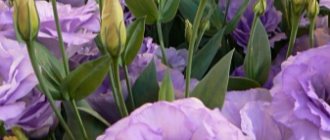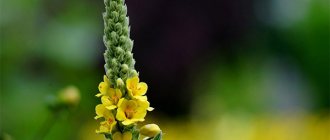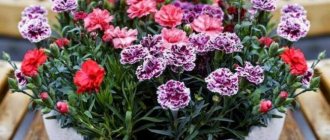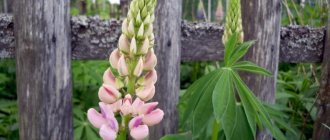Description of Kobei
Kobeya is an ornamental vine. Its homeland is Mexico and Peru, where it blooms almost all year round as a perennial and serves as decoration for facades and gazebos. In Russia, the flower is considered an annual, since it is not able to survive the winter even in the southern regions, unless we are talking about greenhouse cultivation.
In our country, only one variety of kobei has taken root - climbing.
Under favorable conditions, its shoots can reach 7 meters in length, but the average is 4 meters. Leaves are oval shaped. In summer they are green, but when it gets colder they change color to red-violet. Therefore, even in the absence of flowering, kobeya looks quite attractive at the end of the season.
In mid-summer, cup-shaped buds appear on the vine. Their diameter is 7-8 cm. The color of the petals can be white, lilac (purple) or pink. After flowering is completed, green, egg-shaped fruits are formed.
Interesting! Experienced flower growers note that white kobeya is the most capricious variety of flower.
In some growing regions it is not possible to wait for them, since frosts occur quite early.
Main types and varieties with photos
Tenacious kobeya, or climbing kobeya, creeping kobeya (Cobaea scandens)
This species is the only one that is cultivated. In total, there are 9 species of kobei in nature. This species is a perennial vine that is cultivated as an annual. This plant is native to Mexico. This vine grows a large number of stems, reaching a length of 6 m. The feathery leaf plates end in branched tendrils, with which the plant clings to the support. Flowering lasts from the second half of summer until frost. The purple flowers have a honey scent. White cobea (Cobea scandens alba) is a subspecies of tenacious cobea and has white flowers.
COBEIA - DIFFICULTIES OF GROWING.
Briefly about the features of growing kobei in the table
The table below gives a brief description of the kobeya regarding its planting and care.
| Landing | Seeds: end of February. Seedlings: late May-early June. |
| Soil requirements | Sufficiently fertilized, fertile land. |
| Lighting | Kobeya needs good lighting; slight natural shading of the plantings is allowed. |
| Garter | Not required, the climbing plant tenaciously clings to the support. |
| Bloom | From the second half of summer until the onset of the first frost. |
| Watering | It is unacceptable for the soil to dry out completely; watering should be moderate, but quite frequent, especially in hot weather. |
| Reproduction | Using cuttings and seeds. |
| Feeding | Nitrogen during the period of shoot growth, potassium and phosphorus at the stage of bud formation. |
| Pests | Affected by aphids and spider mites. |
| Diseases | Gray and root rot. |
| Growing regions | Central and Northwestern regions, Southern and Middle Urals, Siberia (regions with a temperate climate). |
Sowing and planting kobei according to the Lunar calendar for 2022
Kobeya is grown through seedlings, as it takes a long time to germinate. Some gardeners recommend starting sowing seeds at the end of January. Grown seedlings can be planted in the ground when the threat of frost has passed. As a rule, this is the end of May - beginning of June. Sometimes folk signs can come to the rescue, for example, if it’s cold on March 21, then you should wait a little while planting the kobeya in the ground, as this indicates that the warmth will not come soon.
The table shows favorable dates for sowing and planting kobei in 2021:
| Month | Sowing seeds | Picking seedlings | Transplanting |
| January | 23-25, 30, 31 | — | — |
| February | 3-5, 7-9, 19-24 | — | — |
| March | 14-21, 26-28 | 1-4, 7-9, 30, 31 | — |
| April | — | 15, 16, 22-25 | — |
| May | — | 2-5 | 7-9, 13-15 (only in the south), 28, 29 |
| June | — | — | 9, 16-18, 20-22, 28-31 |
Reviews on how to properly plant kobeya seedlings
Vera Grigorieva, 56 years old, Biysk
If I plan to grow kobeya at home, I am always prepared for the fact that not all the seeds will sprout. I germinate them in advance on a napkin or in a damp towel. It is better to plant one seed at a time in a peat pot, because kobei have a bad attitude towards picking. And one more tip for growing - it is necessary to highlight the seedlings, this procedure is especially relevant in March.
Martynova Irina, 49 years old, Vladikavkaz
Growing kobeya at home is not very difficult. If you germinate the seeds, the task becomes easier. I plant no later than mid-March - then I have time to replant on time. This, of course, is not the easiest flower to grow, but it is very beautiful and everyone will surely like it.
Growing kobeya from seeds at home
When growing from seeds, the key to obtaining healthy seedlings is the choice of high-quality seed material. It is advisable to purchase it from reliable manufacturers. But even in this case, you need to be prepared for the fact that the germination rate of kobei almost never reaches 100%. Therefore, seeds must be purchased in reserve. The cost of one bag varies from 35 to 60 rubles, depending on the variety and manufacturer.
Sowing kobei for seedlings
Germination takes quite a long time, from the moment of sowing to the appearance of shoots it takes about 3 months. Therefore, kobeya is sown at the end of February or at the beginning of March. On some forums you can find information that you can start sowing at the end of January. A wooden box is suitable as a container, and it is better to buy specialized soil that contains a sufficient amount of fertilizers necessary for the plant.
If you use your own soil, it must be calcined or disinfected with a solution of potassium permanganate. It is recommended to pre-germinate seeds for planting. To do this, they are placed in a deep plate on a damp napkin or in a glass with a small amount of water, without touching each other. The top of the container is covered with film.
Some experts recommend carefully piercing them after swelling. In addition, a mucous coating may appear on their surface, which will need to be removed. All these measures will allow the sprout to emerge faster. Sprouted seeds need to be planted to a depth of 15 mm: they are laid out on top of the ground and sprinkled with nutritious soil on top.
Many gardeners prefer another method of germinating seeds and purchase special peat tablets. After getting wet, they increase significantly in volume and soften slightly, so the seeds are simply gently pressed inside.
Containers with seeds are placed in a well-lit, warm place. This could be a window sill, but then it is necessary to exclude drafts. If you use dry seeds, the first sprouts will appear within 2-3 weeks, the germinated material will sprout a little faster.
To summarize, the step-by-step scheme for planting seeds is as follows:
- Germination or planting seeds in a peat tablet.
- Planting in a container.
- Topping
- Hardening.
Caring for kobei seedlings
As soon as 2 full-fledged leaves are formed on the shoots, the kobeya is dived. Together with a lump of earth, it is transplanted into a pot with a volume of at least 3 liters. This will allow strong roots to form.
To create a support, you need to stick a small arch or ladder into the pot. And three weeks before planting in the ground, it is advisable to begin the procedure of hardening the seedlings. To do this, it is placed in a cooler place, for example, on an insulated veranda or balcony. If there are other flowers or seedlings nearby on the windowsill, then it is important to ensure that the loach does not entwine them with its mustache.
If the shoots have reached too large a size, and the time for planting them in fresh air has not yet come, then you can lightly pinch the stem.
Varieties of climbing kobei, which one is better to choose
If you properly care for and look after the loach, it can grow up to 6 meters in length. But you need to decide which variety to grow. There are several types of kobei. They differ in height and color of the bud. Of these, the most popular are Jingle Bells and Kalando.
Jingle Bells is a fast-growing, beautiful vine with bell-shaped flowers in a snowy white cream color. The flowers, by the way, are large - their diameter reaches 8 cm. The liana often reaches a length of 3 meters. At the same time, the plant is heat-loving and prefers to grow in a sunny and sheltered place, away from drafts. The plant blooms for a long time: it starts in July and is interrupted by the first early frosts. Small and large stakes, wallpaper, fittings or any other flat surfaces are used as support.
Large kobea flowers are bell-shaped, their pistil and stamens protrude and are clearly visible.
Calando is also a tall loach . The flowers are also in the form of bells, but their color is sky purple. The flowers are no smaller in size - their diameter is 7 cm. If you plant them in an open place under the sun with fertile soil, then good growth is ensured. Kobeya of this species blooms from July to September. In order for calando to grow faster, it is necessary to remove faded inflorescences in time.
When the flowers just begin to open, they are light green in color. As they grow, the flowers change their color to white or purple in different shades.
Planting kobei in open ground
Next, let's talk about planting and care in open ground. The general condition of the seedlings in the future depends on the correct planting of kobei.
Landing dates
Kobeya can be planted in open ground in consistently warm weather, which prevents the occurrence of night frosts. Even a slight and short-term cold snap can lead to the death of plantings.
In central Russia, this planting period occurs at the end of May or beginning of June. But there is also no need to delay the deadlines, otherwise the process will become much more complicated, the shoots will be difficult to separate from the support, and the risk of their damage increases.
Selecting a location
Kobes love well-lit areas, but at first it is advisable to slightly shade the plantings. Flowers develop well under a small canopy.
They grow best on fertile soil, so you should take care of preparing the flowerbed in the fall by adding humus, peat and superphosphates. Be sure to provide drainage - kobes love loose soil with good permeability. You should not plant them where water regularly stagnates.
Important! Experienced flower growers note that the color of kobei buds can be affected by the acidity of the soil: if it is increased, the color will be brighter; if it is decreased, blue and bluish shades will predominate.
Planting kobei
The seedlings are carefully transferred to previously prepared holes and sprinkled with nutritious soil mixture. The shoots are carefully straightened and placed on a support. It is best to use a ladder or mesh for these purposes. But some people prefer to form an arch out of loaches.
The distance between the bushes must be at least 70 cm, otherwise they will intertwine with each other as they grow.
If you do not carry out the hardening procedure in advance, the adaptation period will be delayed, the leaves and shoots may turn white under the sun.
Care after landing
Planted seedlings require careful care. It includes:
- Watering. It is carried out moderately, but at high temperatures - abundantly, so that the growth of the vine does not stop.
- Weeding. It must be carried out very carefully; the damaged plant will stop developing.
- Feeding. It is carried out 2 times within a month. First you need to apply mineral fertilizers, and after 15 days organic fertilizers. The procedures must be completed at the end of the first summer month, otherwise the buds will not develop due to the abundant foliage.
- Caring for lashes. They need to be tied up, distributed in the right direction, and yellowed foliage must be removed.
The soil must be kept loose. To do this, it is useful to mulch with humus, peat, and sawdust.
The first shoots will begin to appear in July. Flowering will continue until October. The vine will wither only with the onset of frost.
Kobei care
Caring for a kobei is quite simple. You just need to carry out timely watering and periodically apply fertilizers. Flower growers recommend fertilizing every two weeks to get abundant flowering. To do this, you can use specialized preparations or potassium-phosphorus fertilizers.
Watering should be fairly frequent, especially in hot weather. The soil should not stand dry for a long time, otherwise the leaves will begin to wither and turn yellow. Drafts may also be the reason for this.
At first, young plantings must be protected from the scorching sun using a canopy. If the kobeya is part of the landscape design and is planted in a flowerpot or flowerpot in the garden or country house, then it must have a drainage layer. To create it, expanded clay or fine crushed stone is suitable, which is laid out on the bottom of the container. Such a loose cushion will improve aeration and also accelerate the absorption of nutrients from the soil by the roots.
To stimulate growth and flowering, it is recommended to remove faded buds and damaged parts of shoots every two days.
The plant does not require additional tying; it is a creeping plant and clings to the support itself with the help of antennae, the installation of which must be thought out in advance. Some gardeners initially plant kobeya near the walls of the veranda or gazebo. But even at home it looks quite beautiful when it weaves around the balcony. True, indoor vines often sneak into neighboring properties, so it’s better to think through this moment in advance. Judging by the reviews, the wall itself under the vine does not get wet, does not turn black or collapse, as can happen when planting denser and more lush vines.
Landscape compositions using kobeya
The curly beauty in the garden can be used in several ways.
- If you place the plant on the south side of the house, near the gazebo, using trellises you can create a green wall that shields the house from noise and dust.
- It’s good to plant a vine near a fence, “telling” it the direction of movement. The plant will quickly entwine the fence, reliably hiding the area with the house with a beautiful wall.
- By placing several plants in deep containers and placing them around the perimeter, you can decorate your resting place.
- A new design direction - green arches - is a suitable use for quickly spreading kobea plants.
- Lianas can be used to divide the yard into zones.
- Flower beds where flowering vines are combined with verbena, petunia, lobelia and other flowers.
- Planted next to unsightly buildings, charming kobes will not only enliven the garden’s exterior, but will reliably hide all architectural flaws.
Propagation of kobei by cuttings
We offer step-by-step instructions for the process of cutting kobei:
- In spring or August, a cutting about 10-15 cm high is cut under the node.
- Take a glass of warm water (+25 °C).
- The top of the container is covered with a film in which a small cut is made.
- A cutting is inserted into the cut.
- The glass from the cuttings is placed in a well-lit, warm place where there are no drafts.
- After the root appears, you can transplant the plants into a pot of soil.
Some gardeners plant cuttings directly into the ground. In this case, it is very important that it contains a large amount of nutrients.
Kobea cuttings
Kobeya rooted in this way blooms much faster than its counterparts obtained from seeds.
Pests and diseases of kobei
Kobeya quite steadfastly endures the attack of various pathogenic microorganisms, which are characteristic of most vines, but often becomes prey for spider mites or aphids.
Spider mite
Parasites can be detected visually by curled leaf blades. Treatment must be started immediately, before the problem and its consequences become irreversible.
- Treating flowers with an acaricide (Fitoverm, Kleschevit, Iskra) will help get rid of mites.
- The destruction of aphids is carried out with insecticides (Aktara, Tanrek, Apache, Konfidor).
All drugs used are diluted strictly according to the instructions; spraying is carried out in dry, windless weather.
Is it possible to preserve kobeya in winter?
Kobei definitely cannot survive wintering in the open ground in our country. But it is possible to save the plant until the next season; https://mrdachnik.com advises for this:
Cut off all shoots at a distance of 15 cm from the ground, carefully dig the plant out of the soil and transplant it into a pot. Place in a cool room. Ideally, the house has a naturally lit basement where the temperature in winter is +5 °C. Watering during this period is reduced to a minimum. With the onset of spring, the plant needs to be transplanted into new soil, and the frequency of watering should be resumed.











